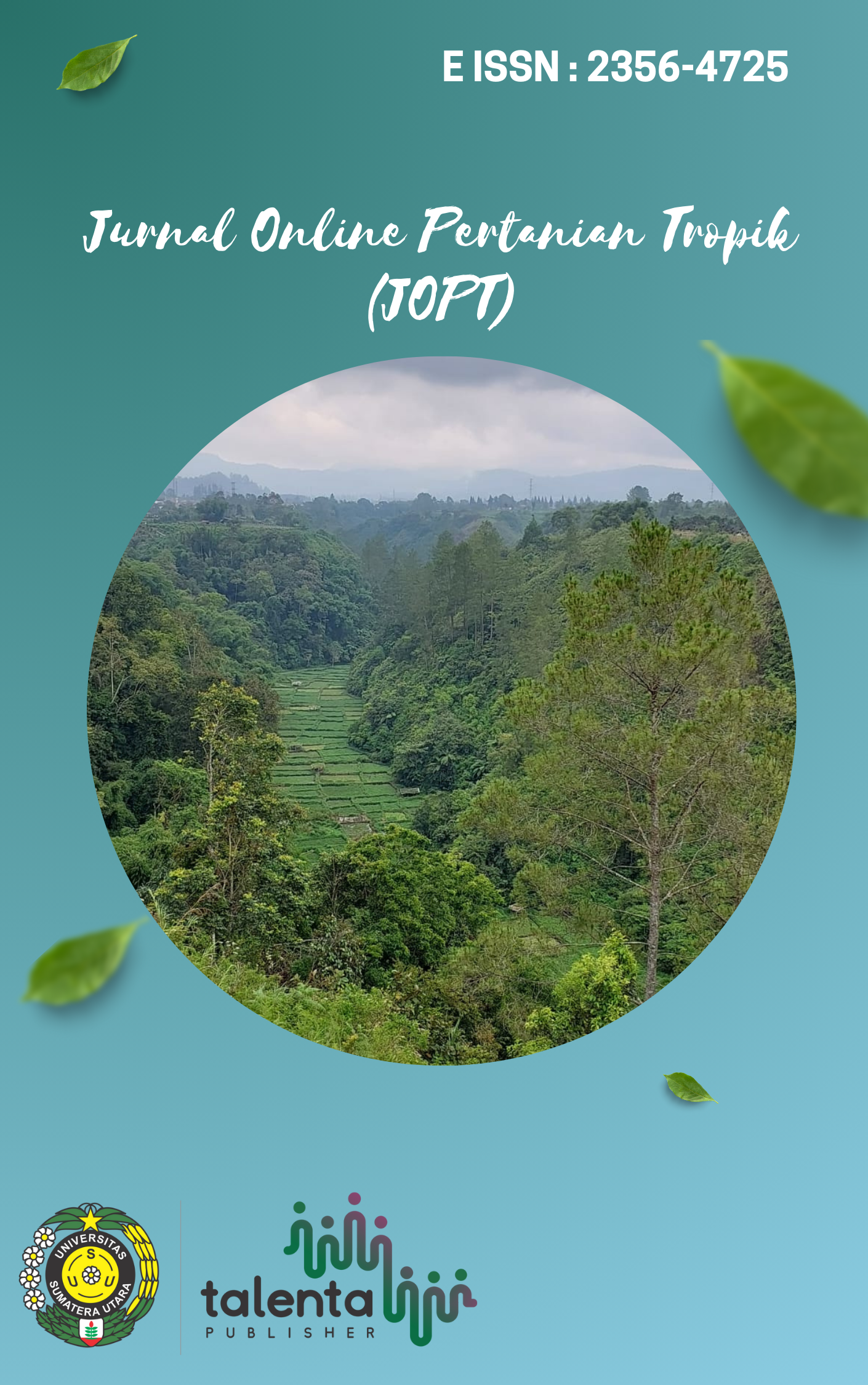Study of the Use of Yeast Types and Soaking Time on the Quality of Cocoa Beans (Theobroma cacao L.)
DOI:
https://doi.org/10.32734/jopt.v9i3.10215Keywords:
cocoa, fermentation, quality, yeastAbstract
The quality of cocoa beans at the farmer level is very low. The main factor that makes the quality of cocoa is low, it of which is fermentation. Improved fermentation will improve the quality of the cocoa beans produced. This study aims to examine the effect of the use of yeast types and soaking time on the quality of cocoa beans. This research has been carried out in the laboratory of the Faculty of Agriculture UISU Medan using a factorial Completely Randomized Design (CRD), which consists of two factors, namely: Factor I type of yeast (R) consisting of 4 levels: R0 = Control; R1 = Bread Yeast; R2 = Tempeh Yeast and R3 = Tape Yeast. Factor II The immersion time (P) consists of 4 levels: P1 = 1 hour; P2 = 2 hours; P3 = 3 hours and P4 = 4 hours with 2 repetitions. Parameters observed were yield, pH, water content, fat content, and organoleptic test of taste and aroma. The data is analyzed using means of variance and if it had a significant effect, then continued with Duncan's Multiple Range Test (DMRT). The results of the study showed that the type of yeast had a significant effect on pH, water content, fat content, and organoleptic test values ​​for taste and aroma. Soaking time has significantly different effects on pH, fat content, and organoleptic test values ​​for taste and aroma. The interaction of the treatment the effect of yeast type and soaking time had no significant effect on all observed parameters. Fermentation of cocoa beans with the addition of yeast can improve the quality of cocoa beans, especially with the addition of baker's yeast and soaking time of 4 hours to produce the highest taste and aroma.
Downloads
References
Apriyanto M., Sutardi S., Harmayani E. And Supriyanto S. 2016. Improvement of the non-fermented cocoa bean fermentation process by adding pure cultures of Saccharomyces cerevesiae, Lacto bacillus lactis, and Acebacter aceti. Agritech, 36(4):410-415.
Apriyanto M., Sutardi S., Supriyanto S., Harmayani E. 2017. Fermentation of dry cocoa beans using Saccharomyces cerevesiae, Lacto bacillus lactis, and Acebacter aceti. Agritech, 37(3):302-311.
Atmaja MP., Haryadi, and Supriyanto. 2016. Improving the quality of non-fermented cacao beans through pre-incubation treatment. TIDP Journal. Vol.3(!):11-20.
De Vuyst L, and Weckxb S. 2016. The cocoa bean fermetation process; from Ecosystem analysis to starter culture development. J.Appl.Microbiol. 121:5-17.
Dirjenbun [Directorate General of Plantations]. 2021. Indonesian Plantation Statistics: Cocoa 2017-2021. Ministry of Agriculture. Jakarta.
(http://sultra.litbang.deptan.go.id.2011).
Hermani and Winda H. 2013. Optimization of nutrient composition for formationof flavor components. Postharvest Journa. Vol.10(2):74-82.
Marwati T., Djaafar TF., Hatmi RU., Ni'Matuzzahra, Purwandari FA and Rahayu ES. 2019. The effect of Lactobacillus plantarum HI-15 in inhibiting the growth of mycotoxin- producing fungi during fermentation of cocoa beans. Journal of Food Technology and Food Chemistry.2(1).
Kadow D., Nicolas N., Sascha R., and Reinhard L. 2015. Fermentation is like incubation of cacao seeds (Theobroma cacao L.). Reconstruction and Guidance of the Fermentation Process.
Marpaung R. And Putri SN. 2019. Organoleptic quality characteristics of processed chocolate with different fermentation times on Lindak (Theobroma cacao L.) cocoa beans. Journal of Agricultural Media.4(2):64.
Misnawi S., Jinap B., and Jamilah B. 2014. Effect of polyphenols on pyrazine formation during cacao liquor roasting. Food Chemistry. 85:73-80.
Mooens F., T. Lefeber, L. De Vuyst. 2014. Oxidation of metabolites highlights the microbial interactions and role of Acetobacter pasteurianus during cacao bean fermentation. Applied and Environmental Microbiology. 80:1848-1857.
Munarso SJ., Kun TD., and Zahra H. 2016. Effect of addition of microbial starter and pulp squeeze on fermentation conditions and quality of cocoa beans. Journal of Agricultural Postharvest Research. 13(3):156-166.
Pramana O and Handoko YA. 2022. Comparison of the fermentation quality of cocoa beans using mixed culture and single culture of Saccharomyces cerevesiae. Journal of Agricultural Technology Education. 8(2):133-144.
Silfia K., Yulia HD., and Wilsa H. 2017. Effect of starter type to improve fermentation time efficiency and proximate analysis of cocoa beans. Industrial R&D Journal. 7(1):53-60.
Widayat HP. 2015. Quality characteristics of Aceh cocoa beans fermented in various ways and at intervals of stirring. Indonesian Journal of Agricultural Technology and Industry. 7(1):7-11.
Downloads
Published
How to Cite
Issue
Section
License
Copyright (c) 2022 Jurnal Pertanian Tropik

This work is licensed under a Creative Commons Attribution-ShareAlike 4.0 International License.






















